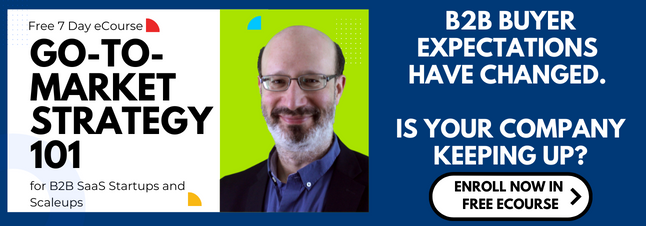Buyer’s journeys today look more circular than linear, where the results you achieve for your customers dramatically impact your ability to attract more prospective customers and grow faster. Go-to-market professionals visually represent this process as B2B flywheel marketing.
In this video, you’ll learn why digital word of mouth plays such an important role in many B2B buyer’s journeys, how to represent this more circular journey as a flywheel, and what B2B flywheel marketing looks like.
B2B buyers research and make purchase decisions very differently than they did as recently as a few years ago. Digital word-of-mouth, in the form of reviews or social proof, plays a huge role in determining your company's ability, or lack thereof, to transform your most delighted customers into sources of future customers.
Why?
Because quite simply, people trust their peers way more than they trust most marketing and sales professionals.
The latest research from Gartner found that 83% of a typical B2B purchase decision -- researching, comparing options, and evaluating pricing -- happens before a potential buyer engages with a vendor.
And McKinsey & Company has discovered that 70% to 80% of B2B decision-makers now prefer to make decisions digitally.
In its B2B Thought Leadership Impact Report, LinkedIn, in partnership with Edelman, concluded that “thought leadership remains critical to customer engagement but breaking through the noise is harder than ever.”
As digital word of mouth at the end of your ideal customers’ buyer's journeys directly impact the quality and quantity of your company’s digital visibility and reputation, many go-to-market professionals now visually represent the end results of traffic generation, all the way down to company growth, through a flywheel
Wikipedia defines a flywheel as “a mechanical device which uses the conservation of angular momentum to store rotational energy.”
So what kinds of marketing and sales inputs add rotation energy to the flywheel?
In other words, what are the building blocks of B2B flywheel marketing?

First, traffic generation helps strangers discover your company and typically includes channels such as blogging, search engine optimization (SEO), social publishing, paid search, paid social, public relations, and video.
Next, as traffic passes through to content offers on your website, you’ll end up with lead generation -- the end result of your website’s ability to convert anonymous website visitors into known leads.
After that, a portion of your leads can mature into sales opportunities -- which means that the lead took some action that helps your company identify that person as serious about potentially engaging with your company. Typically by this point, either someone from the sales team has manually reviewed and accepted the lead, or you’ve developed some form of marketing automation programmed to automate the creation of sales opportunities.
With a solid value proposition and an effective sales process, some of your sales opportunities should result in new client acquisition.
After your sales manager rings the gong and high-fives the account executive that got this deal over the finish line to closed won status, your sales and finance teams will likely recognize the initial revenue generation.
For any kind of business model based on subscriptions or recurring revenue, such as software as a service (SaaS), FinTech, or infrastructure as a service (IaaS), the initial revenue generation represents the starting point of what’s hopefully a very long-term mutually beneficial client relationship.
To make this client retention aspiration a reality, your product or service must deliver on its promise with a strong-demonstrable value proposition. And your initial onboarding and ongoing support resources need to optimize clients predictably achieving their initial value, intended value, and extended value as part of sustained customer success.
Next, your go-to-market team, working together with your operations and technology teams, should build scalable, repeatable processes that support and help deliver sustainable revenue generation.
And when all of this is executed well, your company grows. As an extremely valuable byproduct, digital word of mouth fuels more traffic generation as part of the flywheel component of B2B flywheel marketing.
And if you’re serious about B2B Flywheel Marketing,
Learn more when you enroll now in our free 7-day eCourse: Go-to-Market Strategy 101 for B2B SaaS Startups and Scaleups.



Submit a comment